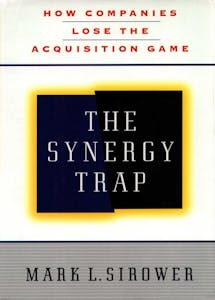With acquisition activity running into the trillions of dollars, it continues to be a favorite for corporate growth strategy, but creating shareholder value remains the most elusive outcome of these corporate strategies—after decades of research and billions of dollars paid in advisory fees, why do these major decisions continue to destroy value?
Building on his groundbreaking research first cited in Business Week, Mark L. Sirower explains how companies often pay too much—and predictably never realize the promises of increased performance and competitiveness—in their quest to acquire other companies. Armed with extensive evidence, Sirower destroys the popular notion that the acquisition premium represents potential value. He provides the first formal and functional definition for synergy -- the specific increases in performance beyond those already expected for companies to achieve independently. Sirower's refreshing nuts-and-bolts analysis of the fundamentals behind acquisition performance cuts sharply through the existing folklore surrounding failed acquisitions, such as lack of "strategic fit" or corporate culture problems, and gives managers the tools to avoid predictable losses in acquisition decisions.
Using several detailed examples of recent major acquisitions and through his masterful integration and extension of techniques from finance and business strategy, Sirower reveals:
-The unique business gamble that acquisitions represent
-The managerial challenges already embedded in current stock prices
-The competitive conditions that must be met and the organizational cornerstones that must be in place for any possibility of synergy
-The precise Required Performance Improvements (RPIs) implicitly embedded in acquisition premiums and the reasons why these RPIs normally dwarf realistic performance gains
-The seductiveness and danger of sophisticated valuation models so often used by advisers
The Synergy Trap is the first exposé of its kind to prove that the tendency of managers to succumb to the "up the ante" philosophy in acquisitions often leads to disastrous ends for their shareholders. Sirower shows that companies must meticulously plan—and account for huge uncertainties—before deciding to enter the acquisition game. To date, Sirower's work is the most comprehensive and rigorous, yet practical, analysis of the drivers of acquisition performance. This definitive book will become required reading for managers, corporate directors, consultants, investors, bankers, and academics involved in the mergers and acquisitions arena.
